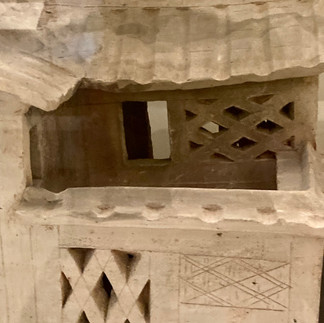In the House of the Dead
- David
- Jun 5, 2023
- 2 min read
Ceramics come from the earth, the mud—extracted, processed, fired, and sometimes consigned back underground, to spend the rest of their life in the darkness as funerary wares. Some of the most elaborate examples of wishful thinking and afterlife-joy come from the Han dynasty in China (206 BC–220 AD), a golden age of economic prosperity and scientific advances, of paper and wheelbarrows and square roots and negative numbers and seismometers. Burials included mingqi or “spirit utensils”—models of everyday things—servants, dancers, acrobats, domestic animals, and the buildings that housed and protected them, providing nourishment, entertainment and comfort for the soul of the tomb’s occupant.[1]
They were an integral part of funerary rites—“entire farms complete with granaries, wells, and watchtowers were recreated in miniature. Details like wooden brackets and tile roofs were loyally reproduced, as were regional differences in building styles, ranging from tall towers in the north, courtyard structures in the south, and houses perched on stilts in marshy areas”[2]—these durable little objects leaving a record of rustic architecture and construction long after the wooden buildings have rotted away. There are a tremendous number of these little figures in museums, their popularization during the Han period reflecting the rise of Confucianism and development of a broader bureaucratic class of scholar-officials who needed a comfortable time in the afterlife.
The Ashmolean has a display of these mingqi from south-east China—cute little bowls, the green-grey of an iron glaze from the Yue kilns, with an animal curled up inside—a pig in a pen, bristled with rough slashes; a snub-nosed dog crouched in frantic play; another dog cross-pawed, relaxed; a chicken coop that would look fancy in any suburban allotment; a house arranged around a open-work walled courtyard, moon gate, tiles and roof-ridge. There are people too—a man cradling a goat, his robe spangled with flowers; a woman and child, her hair fancy and combed up; heavily decorated clothes, hair and whiskers.
The expressions open, calm. This is me with my child; this is me with my goat. This is me with my staff. This is my cooking range, this is my watchtower.
[1] Supposedly the ethereal hun soul flew up to heaven, while the corporeal po soul stayed in the tomb, comforted by the objects—though views on the soul, including how many exactly there were and what they all did, were massively contradictory. [2] Heather Colburn Clydesdale (2009) “The Vibrant Role of Mingqi in Early Chinese Burials.” In Heilbrunn Timeline of Art History. New York: The Metropolitan Museum of Art http://www.metmuseum.org/toah/hd/mgqi/hd_mgqi.htm





















Comments